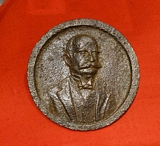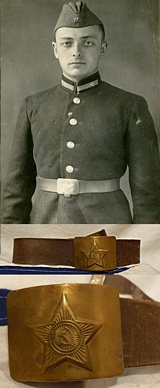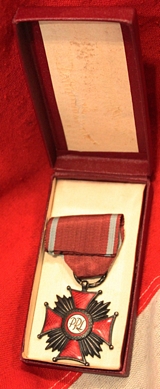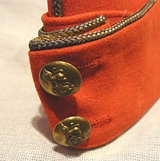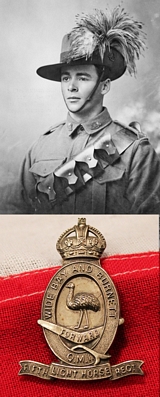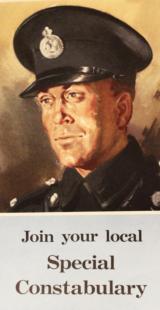WW1 / WW2 / 20th Century
Superb WW1 Slouch Hat Badge of the 5th Mounted Rifle Ortago Hussars
A super original badge of one of the great and heroic New Zealand Horse Regiments. Probably for officers as it is gilded and manufactured with a separate silver central shield attached. Bears a small makers affixed label, Gaunt of London. The Otago Mounted Rifle Regiment was a New Zealand Mounted Regiment formed for service during the Great War. It was formed from units of the Territorial Force consisting of the 5th Mounted Rifles (Otago Hussars) the 7th (Southland) Mounted Rifles and the 12th (Otago) Mounted Rifles. They saw service during the Battle of Gallipoli, with the New Zealand Mounted Rifles Brigade and was later withdrawn to Egypt. They later left the brigade and served in served in France with the New Zealand Division becoming the only New Zealand Mounted troops to serve in France. Battle of Gallipoli
Battle of Flers - Courcelette. 15-22 Sep 1916.
Battle of Morval. 25-28 Sep 1916.
Battle of Le Transloy. 1-18 Oct 1916.
Battle of Messines. 7-14 Jun 1917.
Battle of Polygon Wood. 26 Sep - 3 Oct 1917.
Battle of Broodseinde. 4 Oct 1917.
Battle of Passchendaele. 12 Oct 1917.
Battle of Arras. 28 Mar 1918.
Battle of the Ancre. 5 Apr 1918.
Battle of Albert. 21-23 Aug 1918.
Battle of Bapaume. 31 Aug - 3 Sep 1918.
Battle of Havrincourt. 12 Sep 1918.
Battle of the Canal du Nord. 27 Sep - 1 Oct 1918.
Battle of Cambrai. 8-9 Oct 1918.
Pursuit to the Selle. 9-12 Oct 1918.
Battle of the Selle. 17-25 Oct 1918.
Battle of the Sambre. 4 Nov 1918, including the Capture of Le Quesnoy. read more
295.00 GBP
A Cast Iron Plaque of Graf Von Zeppelin The Pioneer of German Airship Travel, & The First To Realise The Potential of Airship’s Ability of Bombing Combat Against Cities Far Behind Enemy Lines
Dated 1920. Count Ferdinand von Zeppelin (German: Ferdinand Adolf Heinrich August Graf von Zeppelin; 8 July 1838 – 8 March 1917) was a German general and later inventor of the Zeppelin rigid airships. His name soon became synonymous with airships and dominated long-distance flight until the 1930s. He founded the company Luftschiffbau Zeppelin.
Ferdinand von Zeppelin served as an official observer with the Union Army during the American Civil War. During the Peninsular Campaign, he visited the balloon camp of Thaddeus S. C. Lowe shortly after Lowe's services were terminated by the Army. Von Zeppelin then travelled to St. Paul, MN where the German-born former Army balloonist John Steiner offered tethered flights. His first ascent in a balloon, made at Saint Paul, Minnesota during this visit, is said to have been the inspiration of his later interest in aeronautics.
Russet finish overall. Approx 4 inches read more
45.00 GBP
An Original, Patriotic War Period Infantryman’s, Red Army Russian Service Belt From A WW2 Veteran
Just acquired from it's original owner who served in the USSR's Red army in WW2 and in the early Cold War Era. This was his Red Star service belt that he wore, and another belt we show in the gallery was from his comrade who served in the USSR navy [now sold]. With it's original leather belt. A most scarce original example straight from it's original owner. The Red Workers' and Peasants' Army was the name given to the army and the air force of the Russian Soviet Federative Socialist Republic and from 1922 the Union of Soviet Socialist Republics. It was established in the immediate period after the 1917 October Revolution (Red October or Bolshevik Revolution), when the Bolsheviks constituted an army during the Russian Civil War opposite the military confederations (especially the combined groups summarized under the preamble White Army) of their adversaries. From February 1939, the Red Army, who together with the Soviet Navy, embodied the main component of the Soviet Armed Forces, took the official name "Soviet Army" until its dissolution in December 1991. read more
125.00 GBP
A Polish Republic Order Of Merit Medal with Miniature in Original Box
Originated in 1923. At the time of its establishment in 1923, the Cross of Merit was the highest civilian award in Poland. It was awarded to citizens who went beyond the call of duty in their work for the country and society as a whole. May be awarded twice in each grade to the same person. 1950's PRL centre read more
110.00 GBP
Mightier Yet! Every Day More Planes Every Day More Pilots Original WW2
Propaganda poster for the British wartime RAF and the mighty Hurricane. Printed for HM Stationary Office by J. Weiner Ltd London WC1. A propaganda information and recruitment poster. The size as were used in the underground trains advertising panels, or the back of black cabs. Britain re-created the World War I Ministry of Information for the duration of World War II to generate propaganda to influence the population towards support for the war effort. A wide range of media was employed aimed at local and overseas audiences. Traditional forms such as newspapers and posters were joined by new media including cinema (film), newsreels and radio. A wide range of themes were addressed, fostering hostility to the enemy, support for allies, and specific pro war projects such as conserving metal and growing vegetables. In 1940 in particular, Winston Churchill made many calls for the British to fight on, and for British units to fight until they died rather than submit. His calls for fight to victory inspired a hardening of public opinion. Determination raised the numbers of the Home Guard and inspired a willingness to fight to the last ditch, in a manner rather similar to Japanese determination, and the slogan "You can always take one with you" was used in the grimmest times of the war. British victories were announced to the public for morale purposes, and broadcast to Germany for purposes of undermining morale.
Even during Dunkirk, an optimistic spin was put on how the soldiers were eager to return.
When the U-boat commander Gunther Prien vanished with his submarine U-47, Churchill personally informed the House of Commons, and radio broadcasts to Germany asked, "Where is Prien?" until Germany was forced to acknowledge his loss.
The turn of the war made BBC's war commentaries much more stirring.
We never normally comment on the investment potential of any collectable, but the potential for all underpriced WW1 and WW2 posters must be incredible, for example the more famed poster, 'Keep Calm and Carry On' can now sell for over £20,000.
Good condition 10 inches x 15 inches read more
395.00 GBP
Meissen Porcelain Round The World Zeppelin Flight Medal
1929 GERMANY. 1929 Graf Zeppelin World Flight Medal. Red Porcelain, 50.7mm. Near mint condition.
Obv. Airship over Eastern
Hemisphere globe, GRAF ZEPPELIN WELT
RUNDFLUG . Rev. Airship over Western Hemisphere globe, FRIEDRICHSHAFEN. TOKIO. LOS ANGELES. LAKEHURST . A classic Zeppelin
issue made by the State Porcelain Factory of Meissen, mintmark crossed swords, Kurschwertern . MEISSEN TABLE MEDAL - GRAF ZEPPELIN "AROUND THE WORLD VOYAGE" - 1929. Meissen was one of the premier makers of tableware and porcelain items in Imperial Germany. The firm is hundreds of years old, and has survived to this day. A large-format table medal that salutes the Graf Zeppelin?s (LZ-127) "Around the World Tour." The tour began in Friedrichshafen, Germany, where the Graf Zeppelin was built, and continued on to Tokyo, Los Angeles, and Lakehurst, NJ (where her sister ship, the Hindenburg, exploded in May 1937) before returning to Germany. It measures 2" in diameter and is chocolate brown. It shows hallmarking for Meissen on both sides.In 1929, the Graf Zeppelin, LZ-127, made a world flight, stopping at Friedrichshafen, Tokyo, and Los Angeles. Although the Graf was not the first aircraft to circle the globe, it took only 21 days, 7 hours, 34 minutes, a new record for round-the-world travel by any means. Furthermore, it carried a full passenger load over much previously uncharted land. read more
235.00 GBP
An Edwardian Colonel's Scarlet Cloth Sidecap, of 15th The Kings Hussars. With Gold Bullion Trim.
Good condition overall. With two Lion and Crown buttons for the rank of Colonel and Brigadier, used in WW1.
In the First World War, they landed at Rouen in France on 18 August 1914: the squadrons were attached to different infantry divisions to form the divisional reconnaissance element: A Squadron was attached to 3rd Division, B Squadron was attached to 2nd Division and C Squadron was attached to 1st Division. On 14 April 1915, the squadrons returned to regimental control and the regiment was placed under the command of the 9th Cavalry Brigade in the 1st Cavalry Division. The regiment remained on the Western Front throughout the war. It participated in most of the major actions where cavalry were used as a mounted mobile force. They were also used as dismounted troops and served effectively as infantry. On 11 November 1918, orders were received that the 1st Cavalry Division would lead the advance of the Second Army into Germany, by 6 December 1918, having passed through Namur, the division secured the Rhine bridgehead at Cologne.
The regiments battle honours in the Great War: Mons, Retreat from Mons, Marne 1914, Aisne 1914, Ypres 1914 '15, Langemarck 1914, Gheluvelt, Nonne Bosschen, Frezenberg, Bellewaarde, Somme 1916 '18, Flers-Courcelette, Cambrai 1917 '18, St. Quentin, Rosières, Amiens, Albert 1918, Bapaume 1918, Hindenburg Line, St. Quentin Canal, Beaurevoir, Pursuit to Mons, France and Flanders 1914-18
One of the famed of the regiment, Louis Nolan, was an officer of the 15th Hussars who gained notoriety as the bearer of the ill-fated order precipitating the Charge of the Light Brigade.
Around 30 years ago we were honoured to have acquired the undress sabretache of Captain Nolan of the 15th that carried the order in the ‘Charge’. It was recovered from beneath his slain body and steed, and was previously on loan for display in two museums, including Alexandra Palace, for over 100 years after its return to the family. read more
160.00 GBP
A Superb Silver Australian 5th Light Horse Mobile Infantry Badge
Excellent rare and original example [Wide Bay and Burnett Light Horse] Queensland Mobile Infantry. The history of the 5th Light Horse is distinguished and goes thus; The 5th Light Horse Regiment was raised in Brisbane in September 1914, entirely from men who had enlisted in Queensland, and became part of the 2nd Light Horse Brigade. Sailing from Sydney on 21 December 1914, the regiment disembarked in Egypt on 1 February 1915.
The light horse were considered unsuitable for the initial operations at Gallipoli, but were subsequently deployed without their horses to reinforce the infantry. The 2nd Light Horse Brigade landed in late May 1915 and was attached to the 1st Australian Division. The 5th Light Horse played a defensive role for most of the campaign but was involved in several minor attacks. It left the peninsula on 20 December 1915.
Back in Egypt, the 2nd Light Horse Brigade became part of the ANZAC Mounted Division and in February 1916 joined the forces defending the Suez Canal from a Turkish advance across the Sinai Desert. The 5th Light Horse?s main activity in the Sinai was long-range patrolling, but it was involved in several small engagements during August, as the Turks retreated after their defeat at Romani.
The ANZAC Mounted Division advanced into Palestine in late December 1916. The 5th?s work predominantly continued to be patrols and raids until the advance stalled before the Turkish bastion of Gaza. The regiment participated in all three battles aimed at capturing the town, most notably the first abortive attempt on 27 March 1917. On this occasion the 5th attacked Gaza from the rear and was fighting its way through streets and gardens when ordered to withdraw.
With the fall of Gaza on 7 November 1917, the Turkish position in southern Palestine collapsed. The 5th was involved in the pursuit that followed, and then spent much of the first half of 1918 holding the west bank of the Jordan River. During this time it was involved in the Amman (24?27 February) and Es Salt (30 April?4 May) raids, both of which were tactical failures but helped to convince the Turks that the next offensive would be launched across the Jordan.
Instead, the offensive was launched along the coast in September 1918, with the 5th taking part in a subsidiary effort east of the Jordan. It attacked at Amman on 25 September, and on 29 September 4,500 Turks surrendered to just two squadrons from the regiment at Ziza. Turkey surrendered on 31 October 1918, but the 5th Light Horse was employed one last time to assist in putting down the Egyptian revolt of early 1919. It sailed for home on 28 June 1919. Text from AWM
One of the most famous men of the 5th Light Horse was sniper Trooper Sing at Gallipoli. Trooper Sing sniped from a position known as Chatham's Post, his tally stated as 150 confirmed, but a higher informal estimate puts his tally at 201. The discrepancy can be accounted for by the way such hits were recorded. On 23 October 1915, General Birdwood issued an order containing his compliments on Trooper Billy Sing's performance accounting for the 201 Turks. Private Sing was awarded the Belgian Croix de Guerre in early 1918, probably for his role in leading a patrol eliminating some German snipers at Polygon Wood in September 1917. Studio portrait in the gallery is of 1707 Lance Corporal (L Cpl) John James Marsh, 5th Light Horse Regiment from Murraria, Queensland. A 21 year old grocer prior to enlisting on 18 August 1915, he embarked for overseas with the 11th Reinforcements from Sydney on 21 October 1915 aboard HMAT Hawkes Bay. He served with the regiment in the Middle East where he was wounded in action at Gaza and died on 6 November 1917. L Cpl Marsh is buried in the Beersheba War Cemetery, Israel. Original badge, pattern1930/42, with two lug fixing in superb order and superb quality definition. read more
295.00 GBP
An Original WW2 British Special Constabulary Recruitment Poster
Published for HMG by Fosh and Cross Ltd London. A propaganda information and recruitment poster. The size as were used in the underground trains advertising panels, or the back of black cabs. Britain re-created the World War I Ministry of Information for the duration of World War II to generate propaganda to influence the population towards support for the war effort. A wide range of media was employed aimed at local and overseas audiences. Traditional forms such as newspapers and posters were joined by new media including cinema (film), newsreels and radio. A wide range of themes were addressed, fostering hostility to the enemy, support for allies, and specific pro war projects such as conserving metal and growing vegetables. In 1940 in particular, Winston Churchill made many calls for the British to fight on, and for British units to fight until they died rather than submit. His calls for fight to victory inspired a hardening of public opinion. Determination raised the numbers of the Home Guard and inspired a willingness to fight to the last ditch, in a manner rather similar to Japanese determination, and the slogan "You can always take one with you" was used in the grimmest times of the war. British victories were announced to the public for morale purposes, and broadcast to Germany for purposes of undermining morale.
Even during Dunkirk, an optimistic spin was put on how the soldiers were eager to return.
When the U-boat commander Gunther Prien vanished with his submarine U-47, Churchill personally informed the House of Commons, and radio broadcasts to Germany asked, "Where is Prien?" until Germany was forced to acknowledge his loss.
The turn of the war made BBC's war commentaries much more stirring.
We never normally comment on the investment potential of any collectable, but the potential for all underpriced WW1 and WW2 posters must be incredible, for example the more famed poster, 'Keep Calm and Carry On' can now sell for over £20,000.
Good condition 14.75 inches x 9.75 inches read more
295.00 GBP
Celtic Sgian Dubh with Polished Pewter Celtic Knotwork Patterned Mounts. For Wear In Full Highland Dress,
Ball knop top. A bright polished steel blade in a Sgian Dubh presentation box.
The sgian-dubh is a small, single-edged knife worn as part of traditional Scottish Highland dress along with the kilt. Originally used for eating and preparing fruit, meat, and cutting bread and cheese, as well as serving for other more general day-to-day uses such as cutting material and protection, it is now worn as part of traditional Scottish dress tucked into the top of the kilt hose with only the upper portion of the hilt visible. The sgian-dubh is normally worn on the same side as the dominant hand.
The sgian-dubh may have evolved from the sgian-achlais, a dagger that could be concealed under the armpit. Used by the Scots of the 17th and 18th centuries, this knife was slightly larger than the average modern sgian-dubh and was carried in the upper sleeve or lining of the body of the jacket.
Courtesy and etiquette would demand that when entering the home of a friend, any concealed weapons would be revealed. It follows that the sgian-achlais would be removed from its hiding place and displayed in the stocking top held securely by the garters
Vintage, around 10 years old read more
45.00 GBP



